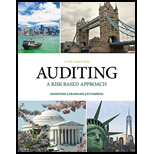
Auditing: A Risk Based-Approach (MindTap Course List)
11th Edition
ISBN: 9781337619455
Author: Karla M Johnstone, Audrey A. Gramling, Larry E. Rittenberg
Publisher: Cengage Learning
expand_more
expand_more
format_list_bulleted
Question
Chapter 1, Problem 12RQSC
To determine
Introduction:Audit refers to providing independent report over the presentation of financial statements of the company. Auditors provide their opinion regarding whether the financial
To explain:Audit quality and list the drivers of audit quality.
Expert Solution & Answer
Want to see the full answer?
Check out a sample textbook solution
Students have asked these similar questions
Norris company's 2013 income statement is ? General accounting
Please provide this question solution general accounting
Don't use ai given answer accounting questions
Chapter 1 Solutions
Auditing: A Risk Based-Approach (MindTap Course List)
Ch. 1 - Prob. 1CYBKCh. 1 - Prob. 2CYBKCh. 1 - Prob. 3CYBKCh. 1 - Prob. 4CYBKCh. 1 - Prob. 5CYBKCh. 1 - Prob. 6CYBKCh. 1 - Prob. 7CYBKCh. 1 - Prob. 8CYBKCh. 1 - Prob. 9CYBKCh. 1 - Prob. 10CYBK
Ch. 1 - Prob. 11CYBKCh. 1 - Prob. 12CYBKCh. 1 - Utilitarian theory holds that what is ethical is...Ch. 1 - Prob. 14CYBKCh. 1 - Which of the following statements related to...Ch. 1 - Utilitarianism does not require which of the...Ch. 1 - Prob. 17CYBKCh. 1 - Prob. 18CYBKCh. 1 - Prob. 19CYBKCh. 1 - Which of the following factors is not an example...Ch. 1 - Prob. 1RQSCCh. 1 - Prob. 2RQSCCh. 1 - Prob. 3RQSCCh. 1 - Prob. 4RQSCCh. 1 - Prob. 5RQSCCh. 1 - Prob. 6RQSCCh. 1 - Prob. 7RQSCCh. 1 - Prob. 8RQSCCh. 1 - Prob. 9RQSCCh. 1 - Prob. 10RQSCCh. 1 - Prob. 11RQSCCh. 1 - Prob. 12RQSCCh. 1 - Prob. 13RQSCCh. 1 - Prob. 14RQSCCh. 1 - Prob. 15RQSCCh. 1 - Prob. 16RQSCCh. 1 - Prob. 17RQSCCh. 1 - Prob. 18RQSCCh. 1 - Prob. 19RQSCCh. 1 - Prob. 20RQSCCh. 1 - Prob. 21RQSCCh. 1 - Prob. 22RQSCCh. 1 - Prob. 23RQSCCh. 1 - Prob. 24RQSCCh. 1 - Prob. 25RQSCCh. 1 - Prob. 26RQSCCh. 1 - Prob. 27RQSCCh. 1 - Prob. 28RQSCCh. 1 - Prob. 29RQSCCh. 1 - Prob. 30RQSCCh. 1 - Prob. 31RQSCCh. 1 - Refer to the Why It Matters feature “What Is...Ch. 1 - Prob. 33RQSCCh. 1 - Prob. 34RQSCCh. 1 - Prob. 35RQSCCh. 1 - Prob. 36RQSCCh. 1 - Prob. 37RQSCCh. 1 - As the auditor for XYZ Company, you discover that...Ch. 1 - Prob. 39RQSCCh. 1 - Prob. 40RQSCCh. 1 - Prob. 41RQSCCh. 1 - Prob. 42RQSCCh. 1 - Prob. 43FFCh. 1 - Prob. 44FFCh. 1 - Prob. 45FFCh. 1 - Prob. 46FF
Knowledge Booster
Similar questions
- Norris company's 2013 income statement is ?arrow_forwardWyly Inc. produces and sells a single product. The selling price of the product is $170.00 per unit, and its variable cost is $68.00 per unit. The fixed expense is $344,160 per month. The break-even in monthly dollar sales is closest to what amount?arrow_forwardCalculate net income? General accountingarrow_forward
- Answer?? Financial accountingarrow_forwardOn the basis of the following data, determine the value of the inventory at the lower of cost or market. Inventory Commodity Quantity Unit Cost Price Unit Market Price Aquarius 20 $ 80 $92 Capricorn 50 70 65 Leo 8 300 280 Scorpio 30 40 30 Taurus 100 90 94arrow_forwardI need this question answer general accountingarrow_forward
- Vyom Inc. Produces and sells a single productarrow_forwardWyly Inc. produces and sells a single product. The selling price of the product is $245.00 per unit and its variable cost is $73.50 per unit. The fixed expense is $417,270 per month. The break-even in monthly dollar sales is closest to: A. $1,390,900 B. $973,630 C. $596,100 D. $417,270arrow_forwardQuestion: General Accountarrow_forward
arrow_back_ios
SEE MORE QUESTIONS
arrow_forward_ios
Recommended textbooks for you
 Auditing: A Risk Based-Approach (MindTap Course L...AccountingISBN:9781337619455Author:Karla M Johnstone, Audrey A. Gramling, Larry E. RittenbergPublisher:Cengage Learning
Auditing: A Risk Based-Approach (MindTap Course L...AccountingISBN:9781337619455Author:Karla M Johnstone, Audrey A. Gramling, Larry E. RittenbergPublisher:Cengage Learning Auditing: A Risk Based-Approach to Conducting a Q...AccountingISBN:9781305080577Author:Karla M Johnstone, Audrey A. Gramling, Larry E. RittenbergPublisher:South-Western College PubBusiness/Professional Ethics Directors/Executives...AccountingISBN:9781337485913Author:BROOKSPublisher:Cengage
Auditing: A Risk Based-Approach to Conducting a Q...AccountingISBN:9781305080577Author:Karla M Johnstone, Audrey A. Gramling, Larry E. RittenbergPublisher:South-Western College PubBusiness/Professional Ethics Directors/Executives...AccountingISBN:9781337485913Author:BROOKSPublisher:Cengage Accounting Information SystemsAccountingISBN:9781337619202Author:Hall, James A.Publisher:Cengage Learning,
Accounting Information SystemsAccountingISBN:9781337619202Author:Hall, James A.Publisher:Cengage Learning,

Auditing: A Risk Based-Approach (MindTap Course L...
Accounting
ISBN:9781337619455
Author:Karla M Johnstone, Audrey A. Gramling, Larry E. Rittenberg
Publisher:Cengage Learning

Auditing: A Risk Based-Approach to Conducting a Q...
Accounting
ISBN:9781305080577
Author:Karla M Johnstone, Audrey A. Gramling, Larry E. Rittenberg
Publisher:South-Western College Pub

Business/Professional Ethics Directors/Executives...
Accounting
ISBN:9781337485913
Author:BROOKS
Publisher:Cengage

Accounting Information Systems
Accounting
ISBN:9781337619202
Author:Hall, James A.
Publisher:Cengage Learning,